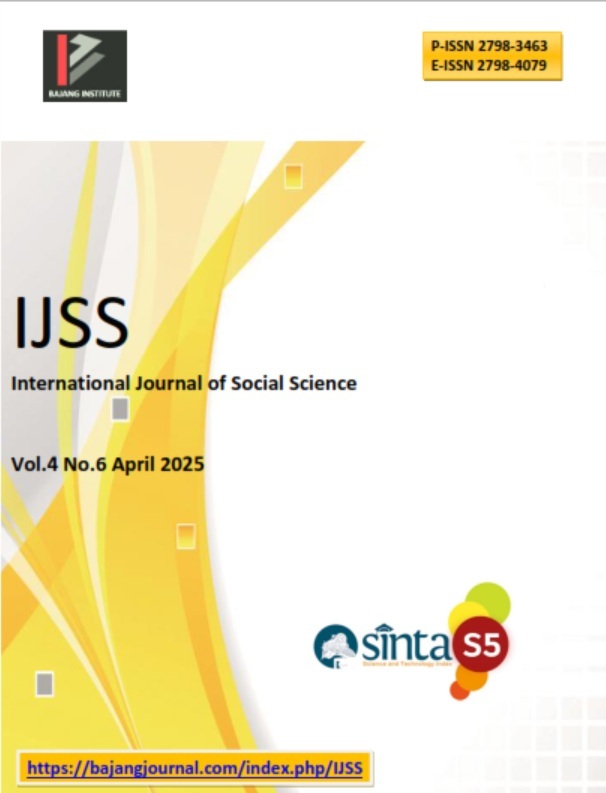PUBLIC PERCEPTION OF AIR POLLUTION IN LANDFILL-ADJACENT COMMUNITIES: THE ROLE OF SOCIO-DEMOGRAPHIC FACTORS IN URBAN INDONESIA
DOI:
https://doi.org/10.53625/ijss.v4i6.10482Keywords:
Air Pollution, Public Perception, LandfillAbstract
Objective: This study aimed to determine the relationship between socio-demographic characteristics such as age, gender, education level, employment status, time spent at home, length of residence, and proximity to landfill with public perception of air pollution among communities living near landfill sites in urban Indonesia.
Study Design: Quantitative, descriptive cross-sectional study.
Place and Duration of Study: Conducted in a landfill-adjacent urban area in Tanjungpinang, Kepulauan Riau, Indonesia, from May 6 to May 8, 2024.
Methodology: A total of 50 respondents aged 18 years and above were selected using purposive sampling. Data were collected through structured questionnaires assessing demographic characteristics and perceptions of air quality. Statistical analysis was conducted using descriptive statistics and chi-square tests with a significance level of p < 0.05.
Results: The study found statistically significant associations between education level and perception of air pollution (p = 0.020), as well as between employment status and perception (p = 0.020). Other factors—age, gender, time spent at home, length of residence, and distance from the landfill—were not significantly associated with air pollution perception.
Conclusion: Education and employment status play a key role in shaping how communities perceive air pollution near landfill sites. These findings suggest that environmental health interventions should prioritize public education and awareness programs, especially targeting individuals with lower education levels and those not engaged in formal employment.
References
Kumar G, Vyas S, Sharma SN, Dehalwar K. Challenges of Environmental Health in Waste Management for Peri-urban Areas. In: Solid Waste Management: Advances and Trends to Tackle the SDGs. Springer; 2024. p. 149–68.
Wee ST, Gustiabani Z, Mohamed S. Challenges of landfill operation in tanjungpinang, kepri, indonesia. Int J Sustain Constr Eng Technol. 2021;12(5):205–18.
Manisalidis I, Stavropoulou E, Stavropoulos A, Bezirtzoglou E. Environmental and health impacts of air pollution: a review. Front public Heal. 2020;8:14.
Suryadi I, Lestari VD, Budirman B, Rachmawati S. Pengaruh Paparan Debu Tsp Dan Penggunaan Apd Terhadap Gejala Ispa Pengguna Terminal. Sulolipu Media Komun Sivitas Akad dan Masy. 2022;22(2):333–9.
Jakhar R, Samek L, Styszko K. A comprehensive study of the impact of waste fires on the environment and health. Sustainability. 2023;15(19):14241.
Shin M, Werner AK, Strosnider H, Hines LB, Balluz L, Yip FY. Public Perceptions of Environmental Public Health Risks in the United States. Int J Environ Res Public Health. 2019 Mar;16(6).
Vrijheid M. Health Effects of Residence Near Hazardous Waste Landfill Sites: A Review of Epidemiologic Literature. Environ Health Perspect. 2000 Apr 1;108 Suppl 1:101–12.
Sutisna NA, Rahmiati F, Amin G. Optimalisasi pemanfaatan sekam padi menjadi briket arang sekam untuk menambah pendapatan petani di Desa Sukamaju, Jawa Barat. Agro Bali Agric J. 2021;4(1):116–26.
Pinakidou S. People’s perceptions of air pollution and their awareness of official indexes at the start of the twenty-first century: a review. Discov Environ [Internet]. 2025;3(1). Available from: https://doi.org/10.1007/s44274-025-00213-x
Mitra P, Chakraborty D, Mondal NK. Assessment of household air pollution exposure of tribal women. Sci Total Environ. 2022;817:152869.
Al-Shidi HK, Abdullah Khamis A, and Sulaiman H. Public awareness, perceptions and attitudes on air pollution and its health effects in Muscat, Oman. J Air Waste Manage Assoc [Internet]. 2021 Sep 2;71(9):1159–74. Available from: https://doi.org/10.1080/10962247.2021.1930287
Balžekienė A, Telešienė A, Morkevičius V. Spatial Dependencies and the Relationship between Subjective Perception and Objective Environmental Risks in Lithuania. Sustain. 2022;14(7).
Chandran R, Bindusree AR, Chandran MCS. Understanding public perceptions, attitudes, and awareness of air pollution and its effects on health. In: Impact of Climate Change on Social and Mental Well-Being. Elsevier; 2024. p. 235–57.
Srangsriwong A, Olapiriyakul S, Yenradee P. Factors influencing public perception and impact distance of a municipal solid waste dumpsite in Thailand. Asia-Pacific J Sci Technol. 2019;24(1):1–13.
Browning MHEM, Rigolon A, McAnirlin O, Yoon H (Violet). Where greenspace matters most: A systematic review of urbanicity, greenspace, and physical health. Landsc Urban Plan [Internet]. 2022;217:104233. Available from: https://doi.org/10.1016/j.landurbplan.2021.104233
Zhang Y, Chen J, Wei X, Wu X. Development and Validation of the Haze Risk Perception Scale and Influencing Factor Scale—A Study Based on College Students in Beijing. Int J Environ Res Public Health. 2022;19(8).
A Susana Ramírez, PhD, MPH, Steven Ramondt, PhD, Karina Van Bogart, BA RP, Zuniga B. Public Awareness of Air Pollution and Health Threats: Challenges and Opportunities for Communication Strategies to Improve Environmental Health Literacy. J Clin Sleep Med. 2019;12(2):263–6.
Guo H, Wang Y, Zeren Y, Jiao X. Urban Air Pollution Mitigation for Sustainable Cities: Observation, Modeling, and Control Strategies. In: Handbook of Geospatial Approaches to Sustainable Cities. CRC Press; 2024. p. 184–233.
Boso À, Martínez A, Somos M, Álvarez B, Avedaño C, Hofflinger Á. No Country for Old Men. Assessing Socio-Spatial Relationships Between Air Quality Perceptions and Exposures in Southern Chile. Appl Spat Anal Policy. 2022;15(4):1219–36.
Aswin Giri J, Shiva Nagendra SM. Air pollution perception for air quality management: a systematic review exploring research themes and future perspectives. Environ Res Lett. 2024;19(5).
Downloads
Published
How to Cite
Issue
Section
License
Copyright (c) 2025 Veronika Amelia Simbolon, Luh Pitriyanti, Ristina Rosauli Harianja

This work is licensed under a Creative Commons Attribution 4.0 International License.

















